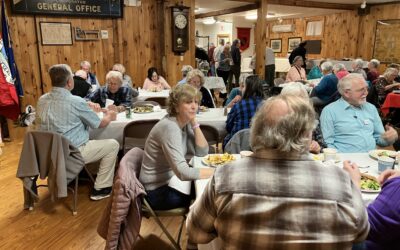Find the monument honoring our Revolutionary War Soldiers in Winthrop Cemetery.
It is the monument in front of the flagpole at Winthrop Cemetery, placed there for the Bicentennial and dedicated in 1976. A wreath is laid there every Memorial Day. The Revolutionary War monument for Deep River was a gift of the American Legion Post #61. These eight men all lived a long life and rest here with their families. Look around, just like Fountain Hill Cemetery, there are many great stories here.
Winthrop Cemetery was established in 1748 by proprietors living in the area who felt there was a need to provide a suitable Burying Ground for the inhabitants of the village. The first person to be buried here was Job Bulkley in 1750.
The soldiers listed on the monument:
George Clark and Joel Doane were farm boys from Winthrop and enlisted together for three years in the Second Regiment of the CT Line in the company commanded by Captain Thomas Converse in the regiment commanded by Col. Herman Swift. They spent their first year together in “Connecticut Village,” winter headquarters for the CT troops in the vicinity of West Point. Both also served in the Light Infantry during their second year. The men chosen for this duty were young, agile, and good shots. Both Doane and Clark served in the Final Formation of the CT Line sometimes referred to as the “Last Arrangement.” The Final Formation was discharged in December 1783 and with it disappeared the last of the CT Line of the Revolutionary Army. Both men went home and took up farming, married, and raised their families. They are buried about 50 feet apart in the old cemetery.
Sgt. Jeremiah Kelsey was another one of the first Deep River residents to volunteer and served as a Private in the 8th Company, 6th regiment, under Captain Samuel Gale of Killingworth, CT, in the regiment commanded by Col. Samuel Parsons from May 10, 1775, to December 19, 1775. Like Dan Platts, he remained in New London until June 17th when the company marched to Boston, where it remained until December. On April 27, 1777, he is listed on the payroll of Capt. Timothy Starkey’s Company of State Militia which responded to an alarm in New Haven. On July 9th, 1779 he responded to the alarm in East Haven as a sergeant in Capt. Bezeliel Bristol’s Company. The British invaded New Haven by sea on July 5th and returned to their fleet in the harbor several days later. Some authorities feel that the large body of militia that quickly formed and marched to defend the city was responsible for the hasty British retreat He died on March 15, 1823, at the age of 83.
Private Samuel Lynde graduated from Yale in 1757, he was the third generation of his family to do so. Upon his father’s death, he inherited a considerable fortune. On February 10, 1781, at the age of 44 years, Samuel enlisted in the Second Regiment of the CT Line for three years. He first served in Capt. Potter’s Company, from Jan until early June of 1783 stationed in the vicinity of West Point. He died on November 2 1792 at the age of 55.
Captain Dan Platts was one of the first Deep River residents to volunteer and served in Captain Kirtland’s Company. This 38-year-old farmer received a commission signed by John Hancock. He was stationed in New London in 1777 when the British raided New Haven. Platt was a Captain in the State Militia and his company was one of those that marched to New Haven to fight. He returned to his farm after the war. He died on February 16, 1826 age 87
Captain Noah Platts was the younger brother of Captain Dan Platts. On April 27, 1777, LT Noah Platts was listed on Captain Timothy Starkey’s Seventh Company of State Militia roster. They arched to New Haven for an alarm. As an officer, he was paid one pound, six shillings, and eightpence for his five days of service, which was more than that received by Sgt Jeremiah Kelsey who served in the same unit. Lt Platts also served in Lt Lee’s Company commanded by Col. William Worthington of Saybrook and was stationed from spring until fall of 1780 as a guard for the town of Guilford. He was later promoted to Captain. He died on October 16, 1811, at the age of 69.
Pvt. Joseph Plumb enlisted at the age of 17 years in April of 1776. He served as a private in Captain Martin Kirtland’s Company, under Col. Erastus Wolcott, commander of the fort at New London. On September 6, 1781, Fort Griswold fell to the British Col Ledyard and 22-year-old Pvt Plumb became a prisoner of war. The British took about 70 prisoners that day. They were all put aboard a ship to New York where they were placed in the “sugar houses.” The “sugar houses” were abandoned warehouses on the wharves of New York. Conditions of overcrowding, starvation, and disease were rampant and many of the prisoners died. Pvt Plumb was placed on a small sloop to Elizabeth, Town Point, New Jersey where he was turned over to American General Skinner and sent home. He died on March 17, 1847, at the age of 88.
Sgt. Jessie Pratt was among those who marched in the alarm to New Haven on April 27, 1777. The record shows that Sgt Pratt was paid eight shillings for five days of service. Miles traveled to and from New Haven were listed as eighty and his travel allowance was six shillings, eightpence. At the time of the march, he was 26 years old. Sgt. Pratt was also among those who signed a petition against the election of Col. William Worthington to the General Assembly. He died on November 30, 1842, at the age of 91 years.
Pvt. Abisha Smith enlisted on January 1, 1776, in a company commanded by Captain Abraham Tyler of Haddam. He was marched to Boston, MA, and spent a year with that company. He also served for two years under Col. Wadsworth at Danbury. He described his duties as packing and dealing out provisions for the army and forage for the horses and teams as well as guard duty. In April of 1779, he enlisted again for six months in a company commanded by Captain Levi Collins, to spend considerable time in New London, CT cutting fascines and procuring materials for fortifications there. After the war Abisha married and returned to his occupation of farming. He died on July 24, 1842, at the age of 88 years.
Pvt. Stephen Utter– In the fall of 1777 British General “Gentleman Johnny” Burgoyne left Canada with a large body of men and proceeded south towards New York. He was met by another British General proceeding north from New York and a third proceeding west from the Mohawk Valley. Their plan was to separate New England from the rest of the colonies. Several Connecticut militia regiments were ordered to reinforce General Israel Putnam on the Hudson during the Burgoyne campaign. Among the enlisted men was Pvt. Stephen Utter of Winthrop in Captain Bezeliel Bristol’s Company in Col. Newberry’s Regiment of militia commanded by Abiel Pease. He enlisted on October 6th and was discharged on December 6, 1777.
The company marched 73 miles to Danbury and from there to Fishkill, New York where they were placed on duty for six weeks. When discharged Pvt Utter was allowed five days travel time from Fishkill back to Winthrop, a distance of 108 miles. He received four pounds for his services and fifteen shillings, one pence for his travel allowance. The British plan did not work, Burgoyne surrendered and his defeat is considered a major turning point in the war. Stephen Utter is listed as one of those that aided the Winthrop Baptist Church with a “gift of real or personal estate.” He died on November 19, 1826, at the age of 58, and is buried next to his wife Hester.
Post your photos to the DR Historical Society Facebook page and have a chance to win a gift certificate to Pizza Grande. Winthrop has a long and interesting history. For more on Winthrop and its inhabitants stop by the Stone House’s new exhibit “From Wharf to Waterfall” to learn more.



